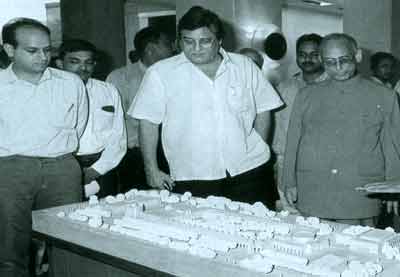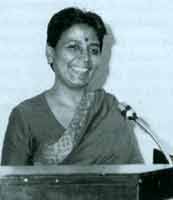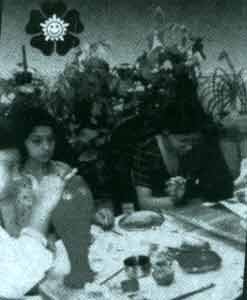EVENTS
Minister of State for Culture Shri Vinod Khanna visits IGNCA

Shri Vinod Khanna, Minister of State for Culture visited IGNCA on August 9. He was received at the Centre by IGNCA Trust President Dr. L.M. Singhvi. Dr. Singhvi briefed the Minister about the activities of the Centre and the status of the new building. Member Secretary Prof. N.R. Shetty and senior officers of IGNCA were present at the meeting. The Minister then paid a visit to Mati Ghar, the unique exhibition venue of IGNCA.
Shri Vinod Khanna then took a tour of the new building. He keenly observed the facilities at the new building. The Minister also showed keen interest in seeing the model of the complete building. He walked around the Library, browsing through the racks. The Culture Informatics Lab (CIL) and the studio of IGNCA were also in the Minister’s itinerary. At the studio, the Minister made certain suggestions for improvement. The CIL programmes held the Minister’s interest considerably as he is keen on exploiting the Information Technology in the field of Culture. A brief meeting of the senior officials and faculty members was organized with the Minister, where a power-point presentation was made on the various activities of the Centre. Though the minister did not make any official statement, he indicated that he would visit the Centre again and help IGNCA in all possible manner.
Terra-Gold of Bishnupur Temples
 |
Alchemy turns fired clay into terra-gold, India has one of the richest and oldest traditions in terracotta. Ancient cultures have valued the images of terracotta as much as those made of gold or ivory, so much so that the same artistes worked on all the material. There is a rich collection of terracotta plaques and sculptures from proto-historic period to the more recent period. In Bengal, the terracotta relief as adornment to sacred architecture is cosmic and its form and content is similar to the narrative scrolls and the Balucher silk of Bishnupur. |
Dr. Arputha Rani Sengupta, who is the Head of the Department of Hisitory of Art, National Museum Institute delivered a lecture (July 11) on the Terra-Gold of Bishnupur Temples of West Bengal. The temples of Shyamrai, Jor Bangla and Madan Mohan belong to the 17th century A.D. Located 127 km from Kolkata, the terracotta temples are unique to the cultural history of India.
The swarnalaya or sonar bangla is literally a golden edifice. The astonishing variations in the terracotta plaques cladding the entire walls, vaults, domes, archways and cupolas are meant for glorifying the Gods and the Malla kings, Dr. Sengupta said.
Sage of Kanchi
`Sage of Kanchi’ a documentary produced by The South Indian Education Society, Mumbai, was screened at IGNCA.
The documentary presents the life of the Paramacharya of Kanchi Sri Chandrashekarendra Swamigal, who attained Samadhi in 1994, comprehensively, in a touching tone. The Mahaswamigal is considered an incarnation of God by his devotees. The documentary, using photographs, rare footages (some supplied by IGNCA) and re-constructions has reduced the distance between the narration and the viewer.
The aura of the personality of the Sage is powerful. The important dates in the life of the Acharya have been interspersed in the commentary, not making it a chronological narration. The Acharya, born in Vizhupuram as Swaminathan on May 20, 1884, ascended the seat of Kanchi mutt under an unforeseen circumstance. Though not directly involved in the freedom struggle, the Acharya blessed the movement. When in 1918 Mahatma Gandhi gave a call for supporting Khadi, the Acharya switched to Khadi forever.
He traveled over 5,000 km by foot in his Dharma Yatra, touching all regions of the country in the thirties. The Acharya knew 17 languages including some foreign. When he met Gandhiji at a cowshed in south India, he told Gandhiji that his actions should not hurt a majority of people. Equality is part of our religion and Dharma but nor identity (uniformity).
The Acharya felt that religious conversions would cause disquiet in the society. He directed the setting up of Dharma Rakshaka Samiti in each village whose main tasks were to clean temples and surroundings, peacefully resist religious conversions, protect cows, grow vegetables etc.
The Mahaswamigal sang and played the Veena and his area of interests included history, epigraphy, architecture, sculpture and music. He initiated several moves for the gatherings of scholars for healthy exchange of views.
These are just some glimpses of the personality of the Sage of Kanchi. The documentary gives a wholesome account of the great life of Paramacharya who was described by His Holiness Dalai Lama as the only Monk of the 20th Century. This 69-minute 35 mm colour documentary is available in CD form.
Man ki kriti
 |
Man ki kriti is a unique book. It is book of poems composed by children and recited to their beloved teacher, often through the phone. The teacher is Mrs. Vimla Sahadev, who continues to be in the world of children despite retiring from her school as Principal. Mrs Sehadev encourages children to express their thoughts through poems. The book was released at a function in IGNCA by noted author and novelist Shri Kamleshji, who said he had never released a book like this ever before. He said he felt particularly happy as the atmosphere in which we are today appeared to be stealing away the childhood of our children. In his inimitable style Shri. Kamleshji narrated stories and incidents from his life sending children and the audience into peels of laughter. He urged the children to not only write but also read what others write. He also said the Indian ethos is the belief in co-existence of civilization and not conflict of civilizations, as is seen in the West.
The evening was dominated by children, dressed as different poets. They also presented their poems. Present on the occasion were Subhaash Sethia, Dy. Director of DAVP. Nita Prasad, Editor of Bal Bharti and Prof. Inder Nath Choudury, IGNCA. DAVP has helped Mrs Sahadev in bringing out the book. A visibly emotional Mrs. Sahadev said children are close to her heart and narrated how her children call her up, excited at the idea of a new poem. |
Symposium on Folklore
IGNCA will host an international symposium on Folklore, public Space and Civil Society from October 7 to 11, 2002. The symposium is being held in collaboration with the National Folklore Support Centre (NFSC), Chennai, which receives support from the Ford Foundation. Divided into six sessions and interspersed with performances, the symposium will explore and attempt to understand the contribution of folklore in generating public opinion. The social relevance of folklore, the cross-cultural encounters between various folklores and the nature and form of folklore in the contemporary context are some of the aspects that will be discussed. The symposium will be held in the IGNCA premises with participants from all over India and abroad.
Marine Archaeology at Gujarat
IGNCA-Southern Regional Centre, at Bangalore, organized a special lecture on `Marine Archaeology at Gujarat’ on July 11. Renowned Marine Archaeologist, Dr. S.R. Rao spoke about the importance of the underwater explorations at Dwaraka, its relation to the tracing of the origin of Indus Valley civilization, the technicalities of underwater explorations and the most pressing need to preserve what has already been discovered.
His scientific decipherment of the Indus script, the distinct excavations at Dwaraka, Rangapur, Lothal, Poompuhar and the establishment of the Indian nativity of the Vedic Aryans provide a rich resource. His association in various capacities in academic and research institutions include the Archaeological Survey of India, Indian National Science Academy, National Institute of Oceanography etc. He also has to his credit several books that include `The Lost City of Dvaraka‘ and `Marine Archaeology in India‘ and many research papers. These studies and explorations have had an inspiring influence on the recent findings at the Gulf of Cambay.
Dr. Rao said the finding at Dwaraka was accidental. While repairing the famous temple of Dwarakadeesh at Dwaraka, they came across evidence of a township that had been submerged and destroyed by the sea. Although the date of the township was determined by scientific investigation of pottery to be 1500 B.C., it was difficult to determine whether the site was Dwaraka or not. This led to the important task of locating Dwaraka.
The other reason for Dwaraka gaining importance was the National Science Academy’s keenness in understanding the causes for Dwaraka submerging. Further, it was necessary from the point of oceanography, to establish the rate of rise in the sea level to study the safety of India seaports. There is evidence of a rise in sea level of 10 metres within 3,000 years and that the sea level is rising. In fact after the recent earthquake, the level of water at Bet Dwaraka has risen by one metre.
According to Dr. S.R. Rao, archaeology still has an important problem of tracing the origin and development of Indus Valley and especially with respect to the development of the Indus script that would have taken thousands of years to grow. He also expressed a keen desire to continue digging at Bet Dwaraka and other nearby sites for further evidence.
With Dwaraka awarded the Worldship Trust, Dr. S.R. Rao who is the Indian representative of ICUCH (The International Committee on Underwater Cultural Heritage) committee, emphasized on the urgency in preserving the underwater discoveries. He suggested the construction of a museum housing the antiquities (presently in Goa) and to develop the site as a self-supporting tourist destination. The project report, submitted to the Government, describes the method for constructing a boundary wall around the structure with a cost estimate of 90 million along with the drawings. It also explains ways to preserve the site in the sea by using acrylic tubes where people can go underwater and go around in a transparent tube. Lamenting that nothing has happened for two years he fears that the site will again get covered with sediment or further damaged. Prof. P.V. Krishna Bhatt, Trustee IGNCA and Hon. Coordinator-IGNCA-SRC, lauded the efforts of Dr. S.R. Rao and compared him and his achievements to that of the Matsya avatar akin to obtaining fresh knowledge from the depths of underwater.
Fish Respond to Music?
It has been known for long now that music has therapeutic effect. Various studies have established this fact. Three professors from Tuticorin (Tamil Nadu) have done an experiment on the effect of music on fish. According to them, they observed a change in behaviour of the fish and greater growth when exposed to music. Prof. Vasantha L, A. Jeyakumar and M. Antony Pitchai used six fish (koi carps, Cyprinus carpio carpio) in two tanks. One tank was fitted with a speaker and connected to a cassette player. After a fortnight of acclimatization, the experiment was carried out for four months in two stages, each for an eight-week duration.
When the music was played it was observed by the Professors that the fish stayed close to the speaker and their movement was minimal and only in vertical direction. The growth of the fish was also found to be more. The Professors have suggested that in the light of this, music can be effectively used in aqua culture. Prof. Vasantha is the Principal of V.O.C. College of Education, Tuticorin, Prof. Jeyakumar is in the Department of Zoology and Mr. Pitchai is a research scholar in the same college.




